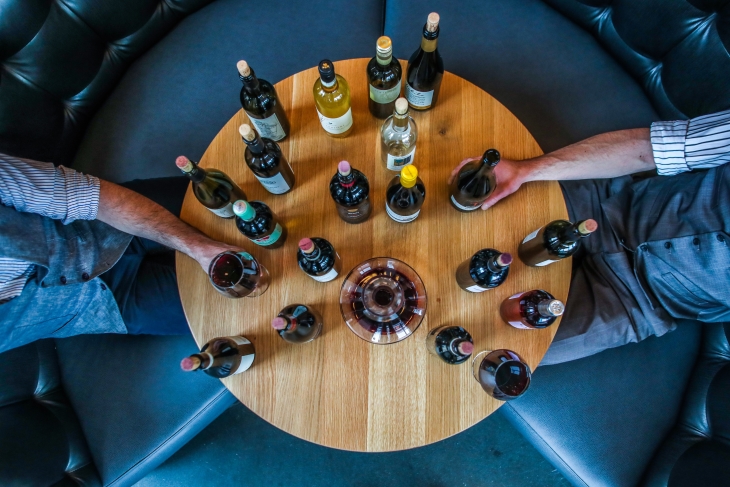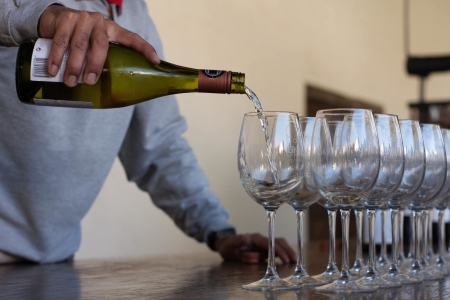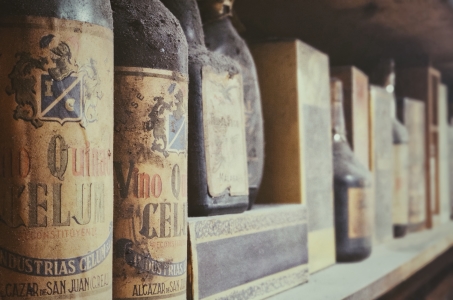What Are the Different Types of Wine?
If you're still learning the basics about wine, you might be overwhelmed by how many different types there are. We're talking about thousands of varieties. So, it can be challenging to figure out what's what, whether a red or white would pair better with your meal, and which variety to try for the first time.
Don't let it get to you. Even the world's leading experts are learning about wine every day, and no one has ever tasted every type and brand of wine available.
That said, it can help to grasp the different wine types, whether you are hoping to invest in wine or simply want to make the most of your drinking experience.
Below, Vint explains some of the most prevalent types of wine and how they differentiate from each other:
What Is Wine?
Wine is fermented juice from a wine grape. Wine grapes are much different from the typical ones you purchase from the market. They are smaller, sweeter, and contain thicker skin. Most wine grapes also have many seeds.
Wine is made from one of two types of grapes. White grapes are technically green, and red grapes are technically black. There are hundreds of varieties between white and black wine grapes, translating to thousands of varietals and blends.
While the specific grape significantly influences a wine's character, it is not the only trait that comprises the uniqueness of a particular wine. Tannins, acidity, body, aroma, age, region, and climate play a critical role in how a wine tastes. Let's dive a little deeper into describing the taste of wine:
What Does Wine Taste Like?
Taste is one of the most subjective qualities for humans, so it is challenging to agree on how specific wines taste. That said, there are a few terms that all of us can use to understand the taste of wine.
For example, sweetness is self-explanatory. Regarding wine, dry is the opposite of sweet, and you can also have an off-dry wine. Off-dry means a faint sweetness to the taste but barely enough to register.
Acidity is a critical factor in all wines. However, this attribute is particularly important in white wines because it determines how crisp and refreshing the wine is. If there is too much acidity, the wine will taste sour, and too little acidity leads to a "flat" taste.
As you learn about wine, you will hear a lot about tannin. Tannins come into play primarily with red wine. We will cover these terms in more detail later, but suffice it to say that lower-tannin wines tend to be softer, smoother, and more drinkable (depending on your palate). High-tannin wines can be astringent and bitter.
When you hear someone discuss the body of a wine, they are talking about the viscosity and weight they perceive. You can identify a full-bodied wine by its thickness and whether or not it sticks to the sides of the bowl of the glass when you swirl it. Light-bodied wines are almost as thin as water, while full-bodied wines have a distinct thickness.
One activity you can try to get a real-world crash course of these wine descriptors is to make a strong cup of tea. Sip the tea without adding anything to it, and you will get an idea of something being highly tannic. Then, put a bit of lemon juice in your tea, and you will taste acidity. The bitter and acidic properties should create an astringent taste. Lastly, drop some sugar into the tea to add sweetness, mellow the other properties, and leave a softer bite.
Red Wine
The dark fruit flavors and tannins of red wines make them pairable with many different foods. And many of the highest quality red wines are aged in oak barrels.
Essential Characteristics
Remember that red wines are created from black grapes; as the winery presses the grapes, the skins mix with the clear juice, which results in the red/purple beverage. Let's talk about some of the most critical characteristics of red wine:
Taste** :** How a specific wine is aged and the grape varieties used strongly influence the flavors and aromas of the wine. Red wines can consist of many different fruit flavors, some of the most common being red cherry, raspberry, strawberry, cranberry, pomegranate, and red plum. Many red wines also have blueberry, black cherry, blackberry, blackcurrant, and black plum.
Old World regions produce wines with hints of wet leaves, barnyards, potting soil, and other earthly aromas. If you wish to taste a jammier, riper wine, look for one from a warmer climate.
Tannins** :** Tannins are the compounds found in grape skins that cause red wine's mouth-drying and bitter taste. Tannins are also preservatives, meaning that most wines with higher tannin tend to age longer than those with lower tannin or no tannin (like white wines).
Tannins and anthocyanins – the particles that give wine its color – fall out of suspension as the red wine ages. This process results in sediment at the bottom of the bottle, and decanting can remove that sediment.
Aging: You will find that many winemakers age their red wines in new oak barrels. Along with enhancing the sweetness of a wine, oak barrel aging can add cardamom, caramel, vanilla, baking spice, and other aromas and flavors.
Varietals** :** You will often see varietal wines, which are wines produced with a single red grape variety. In most cases, such wines will either have the name of the wine's appellation or the grape itself. The latter is more common in the U.S., Australia, South Africa, South America, and other New World regions.
Sometimes, the same type of grape will share different names depending on their region; for instance, Shiraz (Australia) and French Syrah are the same grape.
Common Types of Red Wine
Now that you have an idea of what goes into many of the red wines you see, let's cover a few different types worth knowing about:
Many of the world's most renowned red wines are created by blending different grapes. By far, Bordeaux is the most famous red wine blend. Originating from France, this blend can combine Merlot, Cabernet Sauvignon, Cabernet Franc, and other varieties.
Napa Valley (in California) and some other regions produce similar blends. But they are sold under the label "Meritage" because "Bordeaux" is a protected appellation.
Rioja: This Spanish blended wine primarily uses the Tempranillo grape, the world's third most-planted wine grape. Rioja wines are known for their full body and structure, dryness, woodiness, and plushness—all attributed to the blending of the Tempranillo grape with Carignan, Graciano, and Garnacha, or Grenache (which create Rioja). Rather than region, Rioja wines are classified by how long they have spent aging.
Chianti: Chianti wines come from central Italy and are primarily crafted from a single grape-like Sangiovese. That said, this red wine is sometimes blended with a tiny percentage of other grapes, as allowed by appellation rules.
Syrah: Another famous single varietal wine, Syrah is a red wine named after its grape. Most Syrahs are full-bodied, meaty, and deep. They are also renowned for their dark fruit flavors and drinkability.
Beaujolais: One of the quirkiest French red wines is the Beaujolais. Low in tannin, this fun and fruity wine come in many different styles, some of which resemble Pinot Noir.
Barolo: This Italian red wine is known for its translucent appearance and light red hue. Made with nebbiolo grapes, this wine is sometimes used to make a digestif called Barolo Chinato.
White Wine
The green-skinned grapes used for white wine will yield clear juice (as with black grapes). Winemakers remove the grape skins from the must before the grapes ferment. Because they don't have the tannins of red wines, most white wines rely on acid structure and aroma for their unique qualities.
Essential Characteristics
Here are some characteristics you will want to know about as you explore white wine:
Taste: Many people characterize white wines for their dry or sweet taste. Italian Pinot Grigio is one of the most classic dry white wines. Some winemakers use the same grapes to produce sweet and dry wines. For example, Rieslinggrapes are harvested in Germany during different riping stages, resulting in many sweet and dry styles of wine.
Aroma: Vioginier,, Riesling, and Muscat are some of the most common "aromatic" white wines globally, meaning they have intense floral and fruit aromas. Then there are "semi-aromatic" grapes like Sauvignon Blanc and neutral grapes like Chardonnay. Grapes with lighter aromas make the best white wines for sparkling and oak aging.
Aging: Most white wines are aged in stainless steel tanks. These vessels maintain fruity and floral aromatics, while oak barrels add aromas and flavors. Caramel, baking spices, vanilla, and coconut are common additions.
Varietals: Typically, white wines are produced from a single grape variety. Like red wines, they are usually labeled by appellation in the Old World and variety in the New World. That said, it is more common to see blended white wines in Bordeaux, southern Rhône, Spain, and other specific regions.
Climate: Climate is a big deal in white wines, as it significantly influences flavor and aroma. In cooler temperatures, you will notice that wineries tend to produce wines with orange, lemon, lime, and other citrus fruits. And you see a lot of wines with melon, pineapple, guava, and other tropical fruit coming out of regions with warmer temperatures.
Common Types of White Wine
If you have a taste for white wine, you might enjoy these popular types:
Sauvignon Blanc: It doesn't get much more popular than Sauvignon Blanc. It offers unique citrus and fruity aromatics with refreshing acidity. Whites from New Zealand are known for their bold tropical fruit and jalapeno tones, while some of the best grapefruit and grassy varieties hail from France and The United States..
Pinot Grigio: Pinot Grigio (Italy), or "Pinot Gris" (France), is typically light, dry, and crisp. Most varieties are soft to medium-bodied, though certain Pinot Grigio wines offer a fuller body. It is second only to Chardonnay in popularity regarding white wine.
Riesling: If you're after a floral, fruity wine, explore Riesling. Named for its grape (as are the other white wines listed here), Riesling wine often exhibits white flowers, petrol, citrus, and stone fruit. It is known for its high acidity and light body.
Chardonnay: The world's most popular white wine, Chardonnay is abundant in almost every major wine region. Many people consider this to be the most drinkable wine available. The Chardonnaygrape is versatile because of its natural neutrality and ability to absorb a wide range of characteristics.
Rosé Wine
Rosé wines are pinkish and can include flavors typical to red wines (e.g., cherry, raspberry, strawberry, etc.) and those familiar in white wines (such as tropical fruit and citrus). Though they are made from black grapes, winemakers remove the grape skins from the clear within 24 hours which produces the pink color and imparts minimal tannin.
Sparkling Wine
You can produce sparkling wine from any grape variety, bound only by regional appellation rules. Some sparkling wines are blended while others are single-varietal, and they can be red, white, or rosé.
There are also sweet and dry sparkling wines, albeit most types have added a few grams of sugar to balance out the acidity. Champagne and Prosecco are a few of the most famous sparkling wines.
Fortified Wine
Winemakers add distilled grape spirit to fermented wine to create fortified wines. For the most part, fortified wines are known for their sweetness, though specific Sherry wines are on the dryer side.
Sherry, Port, Marsala, and Madeira are some of the most circulated fortified wines in the world. Vermouth, which is aromatized with botanicals and herbs, is also classified as a fortified wine.
"Wining" Down
Don't get stressed out by thinking about all the different varieties of wine in the world. The information above can give you an excellent idea of the most common types of wine and what they can offer.
If you are looking for a wine to pair with your next meal (or if you want to invest through a platform like Vint), you can reach out to the Vint team for recommendations to help keep cultivating your palate. You never know—you could become the world's next greatest sommelier!
Sources:
Tannins- What are they and what do they do? | Decanter


